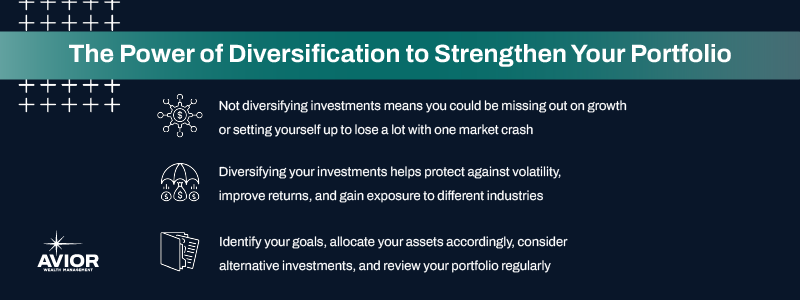The Power of Diversification to Strengthen Your Portfolio
Portfolio diversification helps balance the effects of market volatility and risk with growth potential over time.

Investing is never a straightforward pursuit. Doing it successfully requires knowledge of the markets, which constantly change. It also involves carefully weighing tax implications and risks with growth potential over time. The right investment portfolio will look different for each investor based on their unique short- and long-term goals and financial priorities.
Because it’s hard to predict exactly what economic markets will do, diversification helps strengthen your investment management strategy. Portfolio diversification is the way to spread out risk with asset allocation. For instance, how much will you invest in the stock market versus real estate? How much do you have in liquid cash accounts versus retirement savings?
Diversifying the right way helps you manage tax obligations, balance allocations with your risk tolerance, and optimize performance. Find out what else you need to know about why diversification is necessary.
The risks of a non-diversified portfolio
What happens when you don’t diversify your investment management strategy? Think of the phrase, “putting all your eggs in one basket.” This means don’t bet on just one thing, whether that be only applying to one college or submitting one job application or putting all your money into Bitcoin.
With finances, the risk of non-diversification is that you’ll miss out on both protection from losses and potential growth. If you put everything you have into the stock market, one crash could wipe out all your assets.
Many people think that diversifying just takes investing in different types of stocks or different types of the same asset class. For example, maybe you invest in a couple of different types of cryptocurrency, or you put money into several different fixed-income assets, such as bonds. The risk of putting all your income into fixed-income assets is a lack of growth potential. The risk of only investing in different cryptocurrencies is the whole crypto market seeing a crash.
The benefits of portfolio diversification
Portfolio diversification helps you avoid the risks of putting all your proverbial eggs in one basket that could break. It lets you take advantage of, say, high-growth-potential investments, like equities, while putting some money in fixed-income assets as well. This type of approach helps you balance everything more effectively.
Let’s look at a few other benefits of diversification:
Protect against volatility and uncertainty
Market swings have major impacts on industries and investors. By diversifying, you’re spreading out your risk and thus protecting some of your assets from certain types of swings and crashes. It doesn’t mean you’re not investing in equities and other methods for potentially higher growth; you’re just balancing these with assets that are more protected from market volatility.
Diversification acknowledges an uncertain future and helps you protect your assets against that uncertainty.
Improve returns and performance
Diversifying doesn’t guarantee that you’ll see more growth for your money. But, doing it right can help you improve returns. When one type of asset goes down, chances are, your others are still performing well or at least better.
One study from Strategic Advisors, Inc., found that a hypothetical well-diversified portfolio would have lost a lot less through the market downturns caused by the 2008 financial crisis. This more diversified portfolio included 70% stocks, 25% bonds, and 5% short-term investments, compared to all-stock and all-cash portfolios that would have seen much bigger losses.
Gain exposure to different industries
Diversifying your investments within industries helps you expose your assets to different sectors. This can further strengthen your portfolio since industries go through periods of ups and downs. It gives you flexibility in what you want to invest in and lets you take advantage of consumer trends or respond to national or world events.
Strategies for effective portfolio diversification
Achieving your optimal diversified portfolio may not happen overnight. It takes careful planning and research while aligning strategy with your personal goals. Follow these steps when diversifying:
1. Define your investment priorities
Before investing in different areas, you need to identify your financial goals, risk tolerance, and timeline. Talk to family members who your strategy will impact. List out both short-term and long-term financial priorities and objectives. Consider how comfortable you are taking risks and what your timing looks like for when you’ll need access to funds.
2. Allocate assets accordingly
The way you allocate your assets will depend on your risk comfort level. For example, are you prioritizing growth right now and still have many years until retirement? Or are you investing for more short-term goals and should thus focus on low-risk options?
3. Consider alternative investments
Many people think about stocks, bonds, and cash when they hear diversification. But, expand your horizons. Bring in different sectors, even within the stocks you invest in. Consider going with alternative investments like real estate and mutual or exchange-traded funds which can help you diversify even more.
You may also want to invest more in your hobbies, such as wine or art investing. Collectible markets or precious metals could be compelling options for diversification, depending on your interests and time resources.
4. Review and rebalance over time
Investing is an ongoing endeavor, as is your diversification strategy. Market conditions will change but so may your personal financial goals. In addition, you may become less and less comfortable with risk as you age, or the other way around.
Revisit your portfolio regularly and rebalance it depending on a life change or market swing. Go over your financial goals at least annually to continue diversifying in a way that makes sense.
Talk to a financial advisor about portfolio diversification
Taking these steps will help you set up an investment portfolio that’s diversified to protect against market uncertainty while ensuring growth. Don’t forget to stay proactive with investment planning and prioritizing time to review performance and rebalance when necessary.
Working with a financial expert is key to a stronger portfolio. You can better understand market conditions and tax implications while ensuring you have a plan in place for regular review.
The team at Avior is here to help you through the diversification process. Contact us to learn more about our investment management and financial planning services.
Disclaimer: Nothing contained herein should be construed as legal or tax advice. Avior and our Advisors will work with your attorney and/or tax professional to assist with your legal and tax strategies. Please consult your attorney or tax professional with specific legal and/or tax questions. Investment Management and Financial Planner are offered through Avior Wealth Management, LLC, an SEC-registered investment advisor. Past performance is not a guarantee of future results. Investments are subject to loss, including the loss of principal.
No Comments
Sorry, the comment form is closed at this time.




